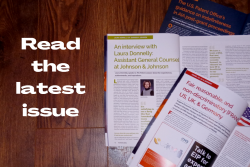If predicting the future were easy, most readers of The Patent Lawyer would be using their powers to buy lottery tickets, not keeping abreast of global patent law updates. Predicting the future, however, is precisely the task attorneys are faced with when drafting a patent application. While you may have an idea of the relevant prior art, this list is unlikely to be exhaustive, and it is impossible to predict how this might be applied by Examiners. You therefore need to future-proof your draft because few patent applications proceed to allowance without any claim amendments. The question is how?
Both the USPTO and EPO prohibit the addition of new matter when making claim amendments. Furthermore, both the USPTO and the EPO apply a standard of review based on the perspective of a skilled person of the art in question. However, these jurisdictions view the ability of the skilled person deriving teachings from the application as filed very differently.
The EPO applies a very strict standard – the “Gold Standard” – when considering allowable amendments. This requires that the amendments can only be made “within the limits of what a skilled person would derive directly and unambiguously, using common general knowledge, and seen objectively and relative to the date of filing, from the whole of these documents as filed.”
The approach taken by the EPO has been interpreted very strictly as almost requiring a literal basis for amendments for the skilled person to be able to directly and unambiguously derive the subject matter of the amendment being sought. In practice, one example of the strict literal basis requirement is often found with respect to the combination of elements.
Specifically, from an EPO perspective, while the Examples and Figures are part of the application as filed, they are usually considered to represent specific embodiments of the invention. Consequently, extrapolating from the Examples and Figures to make generalized claim amendments are frequently unallowable.
The EPO often requires at least a “pointer” to the new combination of features. This means that, for example, a claim amendment that takes a type of metal from page 3 and a type of plastic from page 5 could add matter if there is no pointer to this combination. This is a particular problem for the life sciences, where the so-called “Two Lists Principle” can make it difficult to narrow both a compound definition and a disease indication during prosecution. The EPO suggests that “preferably” can be a suitable pointer in a convergent list—for example, a metal, such as silver, gold, or platinum, preferably platinum. However, “preferably” can be limiting in US litigation (see, e.g., Wang Labs., Inc. v. American Online, Inc., 197 F.3d 1337 (Fed. Cir. 1999); Scimed Life Systems, Inc. v. Advanced Cardiovascular Systems, Inc., 242 F.3d 1337 (Fed. Cir. 2001); Oak Technology, Inc. v. ITC, 248 F.3d 1316 (Fed. Cir. 2001)).
In contrast, the USPTO relies on the written description requirement outlined in 35 U.S.C. §112(a). In order to satisfy the written description requirement, the specification must describe the claimed invention in sufficient detail that one skilled in the art can reasonably conclude the inventor had possession of the claimed invention at the time of filing (see here). Any amendments made to the claim during prosecution will be evaluated against the possession standard. In practice, the USPTO does not require literal support in the specification as filed in order to demonstrate that the skilled person is in possession of the invention. With respect to the combination of elements, the USPTO will often find a skilled person to be in possession of combinations that are not explicitly recited in the specification as filed. Furthermore, the USPTO takes a more lenient approach than that of the EPO when considering the use of the Examples and Figures as a basis for amending the claim.
So, how can you draft a single application that meets the standard of review of both jurisdictions? One option is to write out longhand all possible combinations of features, but this quickly becomes unwieldy. Multiply dependent claims are ideal from an EPO perspective, but quickly become expensive in the US. So far, numbered embodiments seem to be the best option. A numbered embodiments section (e.g., clause section) can provide a basis for combinations without adding an excessive number of pages. It has the further advantage that this can be swapped for the singly-dependent claims on entering the EP regional phase, if a PCT application has been filed with a US-style claim set.
Such numbered embodiments may be seen as tools: a Patent Attorney’s Jell-O™ mould, if you like. While the claims are still being formed, the numbered embodiments can help shape them as you wish. Once finalized, however, they have done their job and can be discarded when amending the description at the end of prosecution.
For more information on added subject matter at the USPTO, EPO, and other IP5 countries, please see our webinar.

Written by Victoria Barker

Written by Sarah Rodriguez

Written by Aaron Capron
You may also like…
Pravin Anand conferred with the APAA Enduring Impact Award
Pre-eminent IP Lawyer and Managing Partner of Anand and Anand, Mr Pravin Anand, has been conferred with the...
The quiet power of confidentiality clubs in SEP litigation
In standard essential patent (SEP) disputes, especially those involving FRAND (Fair, Reasonable, and...
A $10 million patent win reduced to a $1 lesson in damages
In a decision that will resonate as a stark warning to patent litigants, the US Court of Appeals for the Federal...
Contact us to write for out Newsletter














